7 Essential ChatGPT Prompts for Busy Compliance Officers

Compliance officers are turning to ChatGPT to manage an escalating regulatory burden that shows no signs of abating. While precise adoption figures vary across surveys, the trend is clear: AI tools have moved from experimental to essential. What began as tentative experimentation has become standard practice at firms managing everything from anti-money laundering controls to cybersecurity frameworks.
The shift comes as compliance departments face intensifying pressure. Regulatory obligations multiply across jurisdictions while budgets remain flat or shrink. Examinations grow more frequent and intrusive. Into this environment, generative AI has arrived as both solution and new risk vector.
The adoption pattern creates exposure. Organizations are implementing AI tools rapidly, but governance lags behind. Many legal and compliance teams deploy generative models without formal oversight frameworks, creating risks including data leakage, accuracy issues, and potential regulatory violations.
Below are seven prompts compliance officers are using to streamline operations, along with the safeguards required to use them without creating new problems.
1. Summarize New Regulations Quickly
Prompt: Summarize the latest changes in the EU Anti-Money Laundering Directive. Highlight three major updates and explain what actions a compliance team should take in response.
Regulatory monitoring consumes substantial time. New rules emerge from Brussels, Washington, and other capitals in dense legal language across hundreds of pages. ChatGPT can distill these into actionable summaries, helping compliance officers brief executives and update internal policies before deadlines arrive.
The risk: ChatGPT generates plausible-sounding fabrications. Always verify outputs against official regulatory publications. A summary based on hallucinated requirements creates liability, not efficiency.
2. Draft Clearer Policy Language
Prompt: Rewrite this section of our data privacy policy in plain English while keeping all legal obligations intact.
Policies written in legal jargon don’t get read, which undermines compliance itself. Employees who can’t parse what’s required either ignore controls or seek repeated clarifications. ChatGPT can translate complex regulatory language into accessible prose that maintains technical accuracy.
The catch: AI output requires human review before publication. A compliance officer or legal counsel must validate that simplification hasn’t introduced gaps or altered obligations. One error in a published policy can create enterprise-wide exposure.
3. Create Interactive Training Scenarios
Prompt: Develop five short role-play scenarios for a 30-minute training on conflicts of interest, including multiple-choice questions and brief explanations.
Compliance training typically suffers from generic content that employees recognize as recycled year after year. ChatGPT generates fresh scenarios tailored to specific industries, geographies, or organizational cultures. Financial services conflicts differ from healthcare billing issues, and training materials should reflect that.
The constraint: Every scenario requires verification for accuracy and appropriateness. An insensitive example or factually incorrect situation will undermine the entire training session and damage the compliance function’s credibility.
4. Summarize Vendor Due Diligence Reports
Prompt: Summarize this vendor’s 12-page security report into five bullet points highlighting key risks and required follow-up actions.
Third-party risk management generates enormous documentation volume. Security assessments, audit reports, and certification reviews pile up as vendor relationships multiply. ChatGPT can extract key risks and action items, letting compliance officers focus analytical time on material issues rather than document processing.
The requirement: Never upload confidential vendor data to public AI tools. Use enterprise versions with proper data controls, or redact all sensitive information before processing. Exposing vendor security details through an AI tool creates the exact risk the due diligence process aims to prevent.
5. Generate Meeting Summaries and Action Items
Prompt: Convert the following meeting transcript into formal minutes with three action points, assigned owners, and due dates.
Compliance teams conduct numerous regulatory reviews, audit discussions, and policy meetings. Converting notes into formal minutes is necessary but time-intensive. ChatGPT can reduce hours of administrative work to minutes, allowing compliance officers to execute on decisions rather than document them.
The caveat: Confirm final versions with all participants before distribution or filing. Misattributed statements or incorrect action assignments create confusion and accountability gaps that undermine the purpose of maintaining formal records.
6. Prepare Regulatory Responses and Draft Communications
Prompt: Draft a professional response to a regulator regarding a delayed compliance report. Include a clear timeline, mitigation steps, and next actions.
When regulators request information, response quality and speed matter. The tone must be professional, the facts accurate, the commitments realistic. ChatGPT can structure communications and suggest appropriate language, reducing drafting time during high-pressure periods.
The absolute rule: Regulatory correspondence requires legal review without exception. An AI-generated draft is a starting point, never a final product. Send unvetted communications to regulators and you’ll spend subsequent examinations explaining the decision.
7. Conduct a Control Gap Analysis
Prompt: Create a control gap analysis based on ISO 27001 and suggest five prioritized remediation actions for our compliance program.
Mapping internal controls to standards like ISO 27001, SOC 2, or NIST frameworks consumes weeks of manual effort. ChatGPT can generate preliminary assessments and identify obvious gaps, accelerating the initial review phase before more detailed validation work begins.
The limitation: Treat outputs as starting points requiring full validation. Information security and risk teams must verify every recommendation. Auditors will not accept AI-generated assessments as evidence of proper control evaluation.
The Governance Gap
The productivity gains are measurable, but implementation has outpaced governance. Organizations are deploying AI tools in compliance functions without adequate oversight frameworks. The resulting exposure includes data breaches, biased outputs, and factually incorrect advice making its way into regulatory filings or policy documents.
For compliance officers, the answer is formal controls around AI usage itself. That means enterprise versions with data privacy protections, documented prompt review processes, and detailed logs of AI-generated content. These practices align with emerging regulatory expectations for AI accountability, expectations that will become explicit requirements as agencies issue formal guidance.
Practical Implementation
Organizations using AI tools safely in compliance functions follow consistent principles:
Deploy approved tools only. Enterprise versions of ChatGPT and similar platforms offer data privacy controls and audit capabilities that public versions lack. The cost is justified by the risk reduction.
Redact all sensitive data. Client information, confidential financial details, personal identifiers. Strip everything before AI processing. Assume that anything entered into an AI tool could appear in a future breach disclosure.
Maintain comprehensive audit trails. Log prompts, outputs, and approval chains. When regulators or auditors ask how the organization uses AI in compliance functions, documentation proves governance rather than relying on attestations.
Require human sign-off for external communications. Policies, training materials, regulatory correspondence, and any other external-facing content needs review from qualified compliance or legal professionals before distribution.
Train staff on both capabilities and constraints. Employees need explicit guidance on what AI tools can and cannot do, plus clear procedures for proper use. The person who uploads confidential information to a public AI tool often doesn’t understand the implications.
What Comes Next
ChatGPT won’t replace compliance officers, but it will reshape how the function operates. Used with discipline, the prompts above can measurably improve productivity across documentation, training, vendor management, and reporting tasks.
The profession is at an inflection point. Early adopters who implement proper governance now will establish competitive advantages over peers who either avoid AI entirely or deploy it recklessly. As regulatory scrutiny of AI usage intensifies, and it will, organizations with documented, controlled approaches will weather examinations that prove costly for those caught improvising.
The standard for modern compliance management is emerging: AI for efficiency, humans for judgment, and governance frameworks that prove both were applied appropriately.







